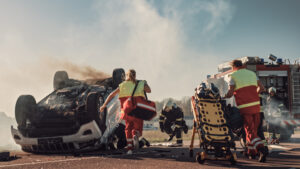For the past two decades, the U.S. Chamber of Commerce has sponsored tort reform measures limiting medical malpractice claims. The U.S. Chamber supports health courts, caps on punitive damages, and other medical liability reforms that restrict access to the courts for injured patients – and it has been successful in many states in promoting these changes. Yet, in the first large study of hospital safety in a decade, results show that patient safety is not improving.
The study, conducted from 2002 to 2007 in 10 North Carolina hospitals, found that harm to patients was common and that the number of incidents did not decrease over time. The most common problems were complications from procedures or drugs and hospital-acquired infections. The study is being published on Thursday in The New England Journal of Medicine.
The study is viewed as the most rigorous to collect data about patient safety since a landmark report in 1999 found that medical mistakes caused as many as 98,000 deaths and more than one million injuries a year in the United States. That report, by the Institute of Medicine, an independent group that advises the government on health matters, led to a national movement to reduce errors and make hospital stays less hazardous to patients’ health.
This was just about the time the U.S. Chamber began aggressively attacking plaintiffs’ lawyers handling medical malpractice lawsuits. But if compromised safety for patients continues to result in deaths and permanent injuries, should not those patients receive an opportunity for a fair award for injuries suffered?
Among the preventable problems identified in this new study were severe bleeding during an operation, serious breathing trouble caused by a procedure that was performed incorrectly, a fall that dislocated a patient’s hip and damaged a nerve, and vaginal cuts caused by a vacuum device used to help deliver a baby.
North Carolina was chosen for the study because its hospitals, compared with those in most states, have been more involved in programs to improve patient safety. But instead of improvements, the researchers found a high rate of problems. About 18 percent of patients were harmed by medical care, some more than once, and 63.1 percent of the injuries were judged to be preventable. Most of the problems were temporary and treatable, but some were serious, and a few — 2.4 percent — caused or contributed to a patient’s death, the study found.
Many of the problems were caused by the failure to use measures that had been proved to avert mistakes and to prevent infections from devices like urinary catheters, ventilators and lines inserted into veins and arteries.
A recent government report found similar results, determining that 13.5 percent of Medicare beneficiaries — 134,000 patients — experienced “adverse events” during hospital stays. According to this October 2008 report, the extra treatment required as a result of the injuries could cost Medicare several billion dollars a year. And in 1.5 percent of the patients — 15,000 in the month studied — medical mistakes contributed to their deaths. That report, issued this month by the inspector general of the Department of Health and Human Services, was based on a sample of Medicare records from patients discharged from hospitals.
The researchers found 588 instances in which a patient was harmed by medical care, or 25.1 injuries per 100 admissions. Not all the problems were serious. Most were temporary and treatable, like a bout with severe low blood sugar from receiving too much insulin or a urinary infection caused by a catheter. But 42.7 percent of them required extra time in the hospital for treatment of problems like an infected surgical incision.
But in 2.9 percent of the cases, patients suffered a permanent injury — brain damage from a stroke that could have been prevented after an operation, for example. A little more than 8 percent of the problems were life-threatening, like severe bleeding during surgery. And 2.4 percent of them caused or contributed to a patient’s death — like bleeding and organ failure after surgery.













Comments for this article are closed.